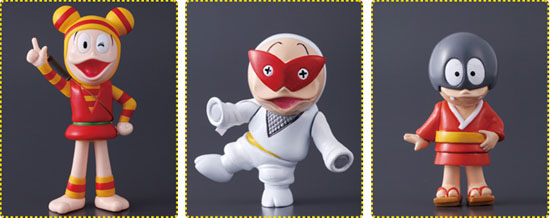
Toei Animation has a long history with animation, producing lavishly-animated features and theatrical shorts since its establishment in 1948.
In the wake of Mushi Production’s success with Astroboy, Toei began producing content for television, the first of which was Ōkami Shōnen Ken (Wolf Boy Ken), which premiered November 25, 1963, on Nihon Educational Television (NET). Contrary to the name, NET (name changed to TV Asahi in 1977) was just another TV station in Japan and was hardly airing any “educational” content by the time they started airing anime. In fact, Toei would be a major supplier for NET’s television line-up throughout the 1960s and ’70s.
Since the beginning, most made-for-TV anime have been based on pre-existing manga, but in the beginning Toei produced mostly original content, which includes Space Patrol Hopper (1965), Hustle Punch (1965-1966, created by veteran animator Yasuji Mori), and Rainbow Squadron Robin (1966-1967). Eventually they started looking into manga to adapt. One of their early adaptations was Sally the Witch, created by Gigantor‘s Mitsuteru Yokoyama, which aired on NET from 1966 to 1968. The show, about a witch princess living in Earth as a human girl, was the first “shojo” anime (girl’s cartoon) to air in Japan, and was a hit.
While Sally was airing, Toei got the rights to adapt another manga called Ninja Awate-Maru (Frantic Ninja), created by cartoonist Jirō Tsunoda (b. 1936), which was published in Weekly Shōnen King from 1965 to 1968. This was a “gag manga” (joke-heavy Japanese comics) about a ninja in training with his younger brother Chibi-Maru.

Humor was always present in Japanese cartoons, but shows that was in the “comedy” genre didn’t truly happen until 1965, when Tokyo Movie produced Obake no Q-Tarō, their first major hit. Soon other studios began to follow path with their own “gag anime,” including Mushi Production’s Goku’s Big Adventure (1967), Studio Zero’s Osomatsu-Kun (1966), and Hōsō Dōga’s Fight!! Pyuta (1968). For Toei, their version of Tsunoda’s ninja comic was their first attempt at “gag anime”, which was re-christened Pyun Pyun Maru for television.
The cartoon centers around an agency called Nandemo OK Jimusho (Everything OK Agency), run by a nameless Boss, a shrewd authority figure whose long beard serves as an extra pair of arms. His ’employees’ are two child ninjas Pyun Pyun Maru and his younger brother Chibi-Maru. As with most bosses in cartoons, their superior will take anything that pays money, no matter how silly or dangerous the job is. Pyun Pyun Maru has a crush on a ninja girl named Sayuri, who often joins him in their assignments. Unfortunately for him, his attempts to get close to her are foiled by Kemeko, a homely ninja girl who has a crush on the main character, much to his chagrin.
To say that this show’s humor is insane is an understatement. It’s very heavy on gags, with slapsticks, Japanese wordplay, nonsense dialogues, and animation gags that was seemingly influenced by Tex Avery cartoons. Western cartoon cliches are common throughout the show: dust-clouds when characters are fighting; round, cartoonish bombs are present; characters using a rocket launcher as a last resort to get a person off of a tree; you name it…
Anachronism plays a big role in this show. Even though the show, in theory, takes place in Samurai-era Japan, there are scenes where the characters watch television, go to a baseball game in an auditorium, drive a car, fly in an airplane, etc. It makes me think that the writers had no clear idea what time-frame this show takes place in, so they just made it up on the spot whenever they wrote an episode.
One of the funniest scenes in the show is during an episode where Pyun and Chibi Maru are going after a buried treasure in a faraway mountain. The bad guys are to trying to get there first so they leave a fake street crossing signal on the path that’s constantly flashing red light. The two main characters actually stop in order to wait for the light to turn green. This goes on overnight, the characters eating dinner, playing game, and watching TV while waiting for the light to turn green. Other people join them in waiting, forming a line. It wasn’t until the following morning that a construction worker removes the sign, leading to the main characters to finally continue their journey.
If Jay Ward ever made an anime…

Pyun Pyun Maru premiered on NET in July 3, 1967, airing on Monday nights at 7:30 pm. All 26 episodes were made in the same production cycle. However, NET abruptly pulled the show from their lineup after the 12th episode aired in the following September. It’s not clear what the reason was, whether it’s because of the lackluster ratings or dissatisfaction of the show’s content from the sponsor, but whatever’s the case, more than a dozen unaired episodes were left collecting dust on a shelf.
The leftover episodes finally aired several years later. In late 1969, NET had finished airing Hanna-Barbera’s Fantastic Four on the same Monday night time-slot that Pyun Pyun Maru aired on back in 1967. Remembering that there are still 14 episodes that hasn’t aired yet, the show resumed broadcast on December 29, 1969. The 26th and final episode aired on March 30, 1970, almost three years after it was completed. Starting next week, NET replaced the show with Japanese-dubbed Wacky Races.

Toei’s first attempt at gag-anime was a failure, and it may have soured them from trying another, but they eventually produced another comedy show in 1969, when they picked up Fujio Akatsuka’s comic Moretsu Ataro, which lasted 90 episodes. And for what its worth, Pyun Pyun Maru went on to gain a minor cult following many years after the fact. Complete collection was released on DVD (first as a box-set, then later as individual volumes), and plastic figurines of the characters were manufactured in 2012 for fans to buy.

Executive Producers: Masaharu Etō, Katsuyuki Ōnuma, Shin’ichi Miyazaki (NET)
Original Comics: Jirō Tsunoda (serialized in “Shonen King”)
Writers: Shun’ichi Yukimuro, Yugō Serikawa, Enrico Trizoni (joint pseudonym of Hisashi Inoue and Morihisa Yamamoto), Jirō Yoshino, Toyohiro Andō, Masao Hayashi, Yoshiaki Nakane, Nagato Kimura, Kenji Urakawa, Jun Teruta, Yoshitake Suzuki, Keisuke Sudō, Kiyosuke Mikuriya, Yō Gōtō
Directors: Tomoharu Katsumata, Yoshikata Nitta, Yugo Serikawa, Tokushige Shirane, Yasuo Yamaguchi, Shizuo Murayama, Takeshi Tamiya, Kazukiyo Shigeno, Yoshio Takami, Kazuya Miyazaki, Yoshio Manō
Animation Directors: Kei’ichiro Kimura, Tsuguyuki Kubo, Masamune Ochiai, Hiroshi Wagatsuma, Akinori Namase, Shin’ya Takahashi, Tetsuhiro Wakabayashi, Makoto Kokubo, Teruo Hosoda
Art Directors: Tomō Fukumoto, Saburo Yokoi, Hideo Chiba
Music: Hirōki Ōgawa


 Charles Brubaker is a cartoonist originally from Japan. In addition to his work for MAD Magazine and SpongeBob Comics, he also created Ask a Cat for GoComics. You can also follow him on his Tumblr page.
Charles Brubaker is a cartoonist originally from Japan. In addition to his work for MAD Magazine and SpongeBob Comics, he also created Ask a Cat for GoComics. You can also follow him on his Tumblr page.











































Interesting show.
I’m guessing the NET in Japan wasn’t related to the NET in the U.S. that served a similar purpose and later morphed into PBS, correct?
No it wasn’t, it was simply a coincidence they used those set of call letters originally.
Your column gives the impression that these 1960s Japanese TV cartoons were in color. Most or all of them were black-&-white, weren’t they?
It was mostly black and white, but gradually they started producing color shows into the late 1960s.
“Pyun Pyun Maru” was one of the first Toei shows to be shot in color (“Sally the Witch” was originally black and white, but starting with episode 18 they switched to color). Even then, however, Toei continued to film some of their shows in B&W until 1970.
It is interesting how that worked otherwise, and I know Charles had talked about this before here (with me bothering to be anecdotal about it all). I’m sure many Japanese families probably didn’t get a color set until much later in the 70’s if they had to wait until the prices came down or what-not.
The first color anime was Osamu Tezuka’s “Kimba the White Lion (Jungle Emperor Leo)” made in 1965.
No, it was/is a commercial enterprise.
http://en.wikipedia.org/wiki/TV_Asahi
What an adorable series. The juxtaposition of feudal Japan and modern technology reminds me of Konami’s comedic Ganbare Goemon franchise.
I love Chibi Maru’s ability to pull out convenient contraptions from his long sleeves. It’s reminiscent of a certain cartoon cow pirate. I also like how Pyun’s hood turned from an Astro Boy-esque hairdo in the comic to Mickey Mouse’s ears in the cartoon.
Hello,
I am very happy to find your website! I have been trying to find the name of a cartoon series about “monsters.” These human like creatures were greenish, bulky and had three fingers (but they looked nothing like kappa.) They wore clothes and seemed to be linked as if in a family. They were rather morose– I remember one episode where at the end one of them was saying something like, “we are so misunderstood by humans.” I do not think this cartoon was translated into English. I saw this cartoon sometime in the 80s, but for some reason I think it was produced much earlier. I also have a vague memory of the word “ben” being in the titled– but I could certainly be wrong. Do you think you recognize the series? Or perhaps you could guide me on how to research this.
Thank you,
Helene
Yokai Ningen BEM
Toei animation wasn’t founded in 1956, it did start animation in 1938 before they founded the animation studio.
I mean 1948.